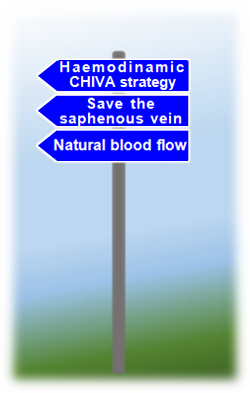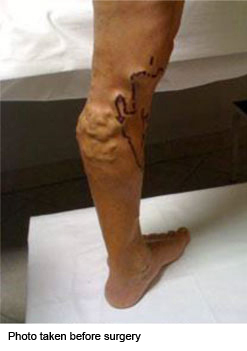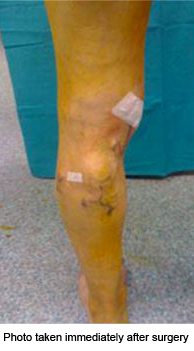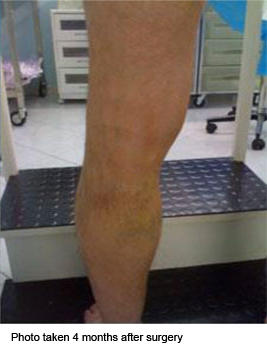The information necessary for making a conscious choice of the therapy for varicose veins of the lower limbs.
The hemodynamic approach of venous pathologies has two fundamental goals for the patient’s health.
1. Preserve the saphenous veins, being aware that they can represent an irreplaceable source of graft for future peripheral or cardiac bypasses and that they can be very important for the drainage of the limb in the case of thrombotic occlusion or destruction due to a trauma of deep venous veins.
2. Preserve the natural drainage of the tissues, essential for the health of the limb, knowing that once the correction has been performed, an adjustment takes place and that the preserved systems are more likely to maintain their stability and have fewer relapses.
What are varices or varicose veins?
Varicose veins are not to be considered the cause of a disease but the symptom of a blood circulation dysfunction that produces a pressure increase in some areas with consequent vein dilation. They are the veins’ answers to an increase in their inner pressure.
What causes blood circulation dysfunction?
Hemodynamic dysfunction is the consequence of some faulty valvular points of the venous systems, where the valves that should allow the blood to flow from the surface to the deep veins and then to the heart are damaged and inefficient. These trigger a flow inversion, the so-called reflux, with a consequent dilation of the veins of that area, which makes up for the increased workload. All this dilation results in the bulging of the skin.
How does conservative hemodynamic surgical treatment operate?
Conservative hemodynamic surgery aims at balancing the blood flow in overloaded and dilated veins, detecting and treating the points of pathological inversion of the flow due to valvular incontinence, which is a characteristic of the disease.
What is the CHIVA hemodynamic treatment?
Cure Conservatrice Hemodynamique de l’Insuffisance Veineuse en Ambulatoire
(Conservative Outpatient Hemodynamic Treatment of Venous Insufficiency)
The CHIVA hemodynamic treatment of varicose veins of the lower limbs is a conservative therapy for treating varicose veins. It is not a surgical technique but rather a scientifically validated method, which helps doctors to develop a therapeutic strategy that uses surgery as its primary operative technique. The CHIVA strategy is based on the knowledge of the mechanisms of the venous circulation, which allows for the formulation of a tailor-made therapy for each patient. It consists of finding a hemodynamic solution that allows for better venous circulation for each patient.
What is the application of the CHIVA hemodynamic treatment?
The method is applied to both primary varicose veins of lower limbs and to deep veins. This enables doctors to help even patients that are suffering impairment of the venous function due to deep venous thrombosis; such cases are the most difficult to diagnose and consequently only physicians that have a good deal of experience with venous corrections and a long and skilled surgical career can perform these therapies.
What is the direction of the flow of the saphenous veins that have been treated and preserved with the CHIVA hemodynamic treatment?
The blood flow in the segment of preserved saphenous vein, which has been treated with the CHIVA method, with saphenous-femoral disconnection, is present but with a direction contrary to the normal one. This represents a good hemodynamic solution. This is a reverse-directed flow but not a pathological one. Inexperienced physicians often confuse it with a persistent pathological reflux. Therefore it is highly recommended that operators that are very experienced in venous hemodynamics carry out check-ups.
The first vascular examination with Echo Color Doppler ultrasound of the lower limbs
The detection of reflux points happens during the first appointment, during the examination of the deep and superficial venous system of both lower limbs, not just one of them. This is possible with proper use of an Echo Color Doppler, which gives information not only about the patient’s anatomy but also and above all about the venous blood circulation. The hemodynamic evaluation is resumed and schematised with a hemodynamic cartography.
 At the end of the examination, the patients receive their hemodynamic maps.
At the end of the examination, the patients receive their hemodynamic maps.
Skilled operators must perform the hemodynamic evaluation with Echo Color Doppler. The physician’s lack of experience in hemodynamics always results in poor results that are not to be blamed on the method but rather on the misunderstanding of the operative mechanisms of the venous system of the examined and treated patient. The same is true for post-operative check-ups that are to be carried out preferably by the same staff which performed the procedure or, if not possible, by physicians that have a perfect knowledge of hemodynamic venous surgery in order to avoid serious mistakes such as confusing a preserved and functioning saphenous vein with CHIVA drainage flow with a saphenous vein with a reflux that is still pathological. It’s a very frequent mistake that has often led to the elimination of a very useful varicose vein without properly informing the patient.
Is CHIVA hemodynamic surgery performed with local anaesthesia?
Yes, it is. The operation is performed using local anaesthesia with small surgical access points. The patient is discharged that same day and patients can soon resume their normal activities.
 Post-operative treatment
Post-operative treatment
Each treatment will require a simple therapy with low molecular weight heparin as a preventive measure but in particular cases it is used as a treatment, too. This helps reduce the chances of thrombotic complications in the deep venous system after surgery. In the case of correction of the external saphenous vein, therapy will last longer than in the case of an internal saphenous vein. In the immediate post-operative period, it is possible for the patient to resume normal daily activities provided they avoid overexerting themselves and as long as they wear elastic stockings, generally 20-24 mm Hg of pressure at the ankle. Patients must make sure that the stocking fits the thigh perfectly without wrinkles, which can have an occlusive effect on the saphenous vein, like a bandage.
After twenty years of performing CHIVA hemodynamic surgeries, we have learned that effective therapy takes time.
Sometimes it is necessary to perform two separate operations; in other cases, when there are several pathological points to be treated, several treatment sessions are recommended. This way, the performed corrections and the type of adjustment of the venous system after these corrections can be checked. The fragmentation of the complex therapy in several stages aims at reducing the impact of the treatment on normal daily life.
 Does the hemodynamic procedure involve constant improvement over a few months?
Does the hemodynamic procedure involve constant improvement over a few months?
Yes, it does. Once the pressure values are back to normal, swelling of the veins tends to rapidly decrease and return to a vein gauge similar to the normal one (with a range of results that depends on the recovery capacity of the vein walls as well as on the consistency of the tissues that surround the veins). This process sometimes takes several months. After six to eight months, possible persisting imperfections can be treated directly at the doctor’s office with some schlerotherapy injections in the collaterals of the saphenous vein. This requires a previous hemodynamic mapping to exclude the presence of escape points left that may feed these venous vessels. This therapeutic system integrates surgery with schlerotherapy.
What is important to know?
Therapy is most efficient when the same physician carries out diagnostics and therapy. If diagnostics and therapy are carried out by different physicians it is necessary for the patient to make sure that there is perfect collaboration between the different physicians and that the surgeon is present during pre-surgery mapping; the absence of the surgeon in this phase reduces the precision of the surgical treatment and consequently increases the chance of relapses. To sum up, it is not possible for the surgeon to plan a hemodynamic conservative therapy only based on what another physician has seen without directly examining the patient himself.
It is important to be informed in order to make a conscious choice.
According to the law, before surgery, during the explanation of the kind of procedure proposed, the patient must be fully informed about all the aspects of the therapy and about its alternatives.
An informed consent that does not contain information about the possibilities of preserving a saphenous vein instead of destroying it should not be valid and destructive treatment may be based on incorrect assumptions, which do not comply with Italian law nor professional ethics. The veins of the lower limbs can be the source of grafts for both peripheral and cardiac vascular bypasses. This is the reason why it is so important for the patient not to miss the opportunity for treatment if it is necessary.
When a destructive treatment, such as the removal of the saphenous vein or its destruction through sclerosis, laser, radiofrequency or steam, is proposed to patients, they should be informed about the loss of a segment that could be used for a future bypass, that is to say of the loss of possible chance of revascularization during informed consent.
Has this hemodynamic therapy received certifications?
Yes, it has. Hemodynamic therapy has been validated by studies carried out according to the rules of the Evidence Medicine and has received an “A” classification, which is the highest mark that can be given to a scientific study.
Such studies say that the percentage of relapses in hemodynamic surgery after five years is lower than the percentage of relapses that arise after stripping procedures. Other destructive procedures, such as laser and radiofrequency, do not have similar comparative studies.
The percentage of relapses with the CHIVA procedure is of 20% after five years.
In the stripping procedure, relapses occur in as many as 40% of cases.
The treatment of relapses after a correctly performed CHIVA hemodynamic procedure is much more favourable than the treatment of relapses after destructive procedures. Only in very few cases does the second treatment involve the loss of the segment of the saphenous vein, which is preserved in any case.
Dr Roberto Delfrate






